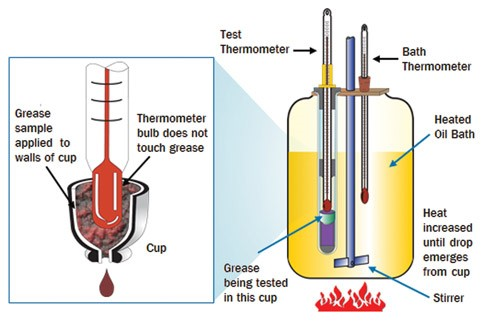
The dropping point indicates a grease’s heat resistance. As the temperature rises, grease softens until it liquefies and loses consistency. The dropping point is the temperature at which grease becomes fluid enough to drip, marking the upper limit at which it retains its structure. However, it is not the maximum usable temperature for the grease.
Understanding the grease dropping point is crucial when selecting lubricants for high-temperature applications. A higher dropping point suggests that the grease can perform effectively at elevated temperatures. This parameter ensures that the chosen lubricant can withstand the operating conditions, thereby enhancing the efficiency and longevity of mechanical components.
Determining Grease Dropping Point
The dropping point test assesses the cohesiveness of a grease’s oil and thickener and identifies when the thickener breaks down. It is used in quality control to ensure the soap structure is properly formed and can endure high temperatures. It is typically conducted on soap-thickened greases, which include simple and complex soaps. These greases are commonly used in bearings across automotive, industrial, and aerospace applications.
The dropping point of grease is determined using standardized tests, primarily ASTM D566 or D2265. In these tests, a grease sample is heated in a controlled environment until it transitions from a semi-solid to a liquid. The grease temperature at which this occurs is recorded as the dropping point. This process helps manufacturers and users choose lubricants appropriate for specific temperature conditions.
The technician monitors the test apparatus to ensure the heater block temperature and sample temperature stay within 3°C of each other as they are slowly heated. When the temperature rises, a drop of oil falls from the cup to the test tube bottom, where the thickener can no longer hold it. The technician records both temperatures to the nearest degree.
To calculate the grease dropping point, subtract the sample temperature from the heater block temperature, then add this value to the sample temperature.
The dropping point test is typically conducted on soap-thickened greases, which include simple and complex soaps. These greases are commonly used in bearings across automotive, industrial, and aerospace applications.

Selecting the Right Grease Lubricants
Original equipment manufacturers commonly advise using grease with a dropping point at least 100 degrees higher than the application temperature. For instance, for an application at 250 degrees, OEMs recommend grease with a 350-degree dropping point.
Grease must also match the machinery’s thermal stability needs by aligning with its operational temperature extremes. This compatibility ensures optimal lubrication, enhances efficiency, and maintains safety standards.
Choose Fluid Solutions for High-Performance Greases
Find the perfect grease lubricant with Fluid Solutions! Since 2008, we’ve been providing top-notch lubrication solutions to manufacturing, steel production, sugar mills, coconut oil mills, and the food and beverage sectors in the Philippines.
Need high-temperature, gear coupling, or multi-purpose greases? Fluid Solutions offers unmatched quality and tailored expertise for any industrial setting.
Contact Fluid Solutions at (02) 8370 5928 / (0917) 894 9156 if you have queries on grease lubricants. You can also send us an email at inquiry@fluidsolutions.com.ph to learn more about how we can enhance the performance and longevity of your equipment. You can also reach us via our official website or social media pages to learn more about our products and services.


